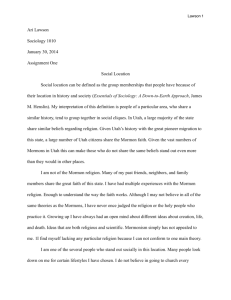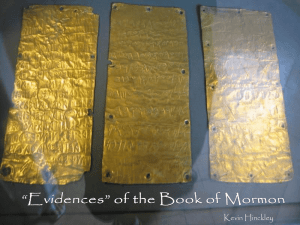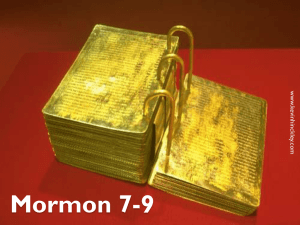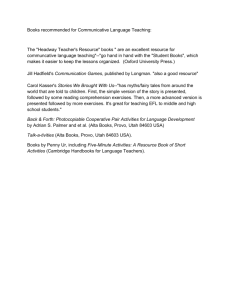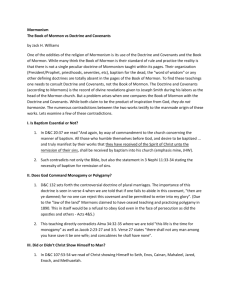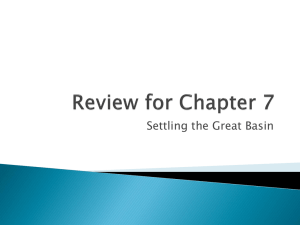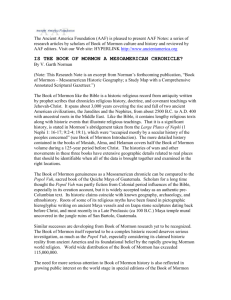January Newsletter.indd - Mormon History Association
advertisement
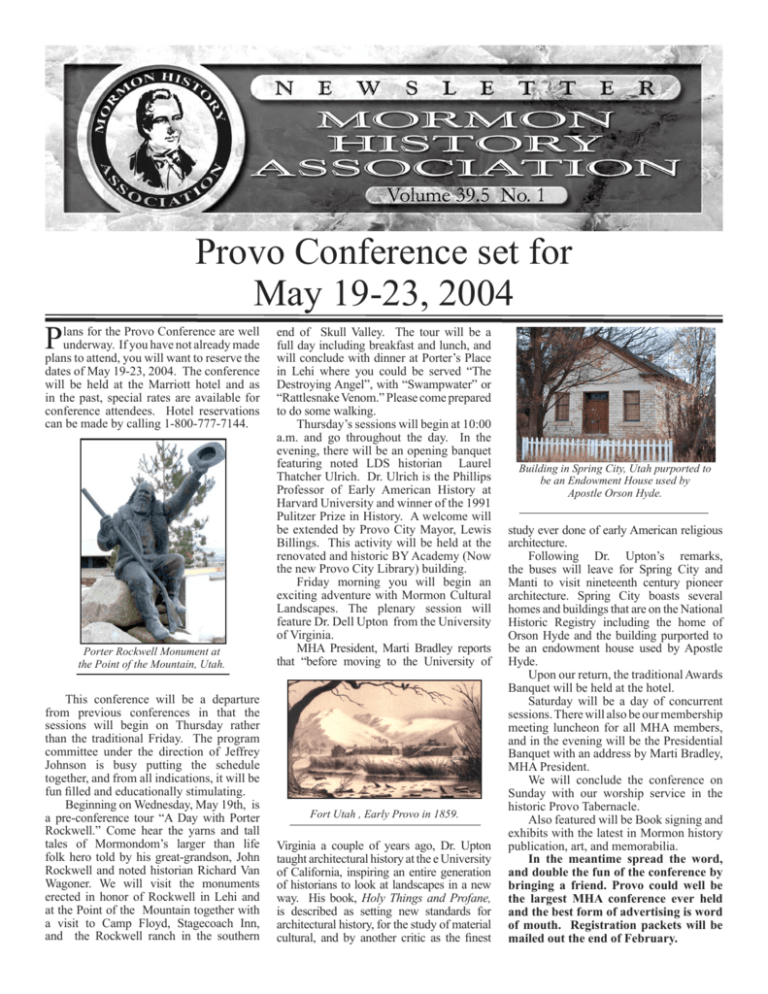
P Provo Conference set for May 19-23, 2004 lans for the Provo Conference are well underway. If you have not already made plans to attend, you will want to reserve the dates of May 19-23, 2004. The conference will be held at the Marriott hotel and as in the past, special rates are available for conference attendees. Hotel reservations can be made by calling 1-800-777-7144. Porter Rockwell Monument at the Point of the Mountain, Utah. This conference will be a departure from previous conferences in that the sessions will begin on Thursday rather than the traditional Friday. The program committee under the direction of Jeffrey Johnson is busy putting the schedule together, and from all indications, it will be fun filled and educationally stimulating. Beginning on Wednesday, May 19th, is a pre-conference tour “A Day with Porter Rockwell.” Come hear the yarns and tall tales of Mormondom’s larger than life folk hero told by his great-grandson, John Rockwell and noted historian Richard Van Wagoner. We will visit the monuments erected in honor of Rockwell in Lehi and at the Point of the Mountain together with a visit to Camp Floyd, Stagecoach Inn, and the Rockwell ranch in the southern end of Skull Valley. The tour will be a full day including breakfast and lunch, and will conclude with dinner at Porter’s Place in Lehi where you could be served “The Destroying Angel”, with “Swampwater” or “Rattlesnake Venom.” Please come prepared to do some walking. Thursday’s sessions will begin at 10:00 a.m. and go throughout the day. In the evening, there will be an opening banquet featuring noted LDS historian Laurel Thatcher Ulrich. Dr. Ulrich is the Phillips Professor of Early American History at Harvard University and winner of the 1991 Pulitzer Prize in History. A welcome will be extended by Provo City Mayor, Lewis Billings. This activity will be held at the renovated and historic BY Academy (Now the new Provo City Library) building. Friday morning you will begin an exciting adventure with Mormon Cultural Landscapes. The plenary session will feature Dr. Dell Upton from the University of Virginia. MHA President, Marti Bradley reports that “before moving to the University of Fort Utah , Early Provo in 1859. Virginia a couple of years ago, Dr. Upton taught architectural history at the e University of California, inspiring an entire generation of historians to look at landscapes in a new way. His book, Holy Things and Profane, is described as setting new standards for architectural history, for the study of material cultural, and by another critic as the finest Building in Spring City, Utah purported to be an Endowment House used by Apostle Orson Hyde. study ever done of early American religious architecture. Following Dr. Upton’s remarks, the buses will leave for Spring City and Manti to visit nineteenth century pioneer architecture. Spring City boasts several homes and buildings that are on the National Historic Registry including the home of Orson Hyde and the building purported to be an endowment house used by Apostle Hyde. Upon our return, the traditional Awards Banquet will be held at the hotel. Saturday will be a day of concurrent sessions. There will also be our membership meeting luncheon for all MHA members, and in the evening will be the Presidential Banquet with an address by Marti Bradley, MHA President. We will conclude the conference on Sunday with our worship service in the historic Provo Tabernacle. Also featured will be Book signing and exhibits with the latest in Mormon history publication, art, and memorabilia. In the meantime spread the word, and double the fun of the conference by bringing a friend. Provo could well be the largest MHA conference ever held and the best form of advertising is word of mouth. Registration packets will be mailed out the end of February. 2 Mormon History Association January 2004 Presidential Message Cultural Landscapes and History Mormon History Association President Martha Sonntag Bradley President-Elect Donald Q. Cannon Past President Lawrence Foster Council Members Brian Q. Cannon J. Stephen Rizley Mark Scherer Patricia Lyn Scott Lola Van Wagenen Maurine Carr Ward Executive Directors Larry & Alene King Published quarterly by the Mormon History Association 581 South 630 East Orem, Utah 84097 801-224-0241 (Voice) 1-888-642-3678 801-224-5684 (Fax) klarry@comcast.net Please send news items, announcements, calls for papers, and letters to Larry & Alene King Volume 39.5 No. 1 A s a historian I have had the privilege of teaching in both a history department and a school of architecture. For me, the juncture between these two worlds has been the vantage point of cultural landscapes which invites us to consider large systems, networks of relationships between people and things, and past and present in a material, physical and tangible world. During the past decade, often I have taken groups of students to Provo’s Center Street to talk about Mormon city building efforts, or Martha (Marty) Sonntag Bradley to Sanpete County to study the lines drawn with the MHA President streets and central squares of the rural towns of Zion. The Mormon History Association conference in Provo creates an opportunity for this type of contrast experiencing both the urban spaces of Utah County’s capital city, and the rural landscape of Central Utah. While the distinction between the two is not as dramatic as it might be in the juxtaposition of a major metropolitan area and its hinterland, it does nevertheless demonstrate the basic village settlement pattern of the nineteenth century world as well as the Mormon city which aspired to gentility, or to culture and civility expressed through its high styled churches, public buildings and schools. Expressing the range of experiences that spread through the Mormon world beyond Salt Lake City, these two places reflect the model of the centerplace—Salt Lake itself with central squares, grided street patterns, churches, theaters and public buildings—but also regional variations that mirror local resources, changed immigrant populations, and the evolution of a type. At our conference next May, when we travel the distance between Provo and Sanpete County on Friday, we will hear papers presented by Professors Thomas Carter and Peter Goss whose work on Sanpete County focuses on the built and social environments as well as the county’s sheep culture. Paul Anderson will give a presentation on the lawn of the Manti Temple, and walking tours of Spring City (a town which reveals its nineteenth century character) will build on the theme running through this conference—the cultural landscapes built by the Mormon world. With the anticipation one feels at the advent of a party planned over months and months, we look forward to this rich experience and hope you will benefit by it as well. As has so often been the case with our annual MHA conference, it will be time spent contemplating what we hear in sessions and what we see or experience on tours. Ideally, our understanding of the Mormon past will be richer as a result. MHA Conference Fun Run We are pleased to announce plans for a Dean May memorial 5K run/walk for Thursday morning, May 20, preceding the Provo MHA conference. The run will be a fund raiser, the proceeds of which will help defray the expenses of graduate students who attend future MHA meetings. We will be asking runners/walkers to solicit pledges from sponsors. Although this is designed primarily to be a run and walk rather than a competitive race, we will have a race timer, and will award prizes to top finishers in various categories. We also plan to have T-shirts (destined, no doubt, to be collector’s items) available. Last, for those who truly want to go the extra mile, we are planning a full marathon for Wednesday, May 19 (the day before the 5K run/walk). Most of all, we urge all MHA members to be generous when approached by our valiant runners and walkers. This is a great cause; one that looks to the future of the MHA as it honors the memory of one of the association’s most beloved leaders. For more information please contact: Sally Gordon at sgordon@law.upenn.edu, or 215898-3069. We look forward to seeing you in Provo! Jennifer Reeder Jed Woodworth Dan and Sally Gordon 3 Mormon History Association MHA Book and Article Awards Every year the Mormon History Association presents to authors, scholars and students over $6,100 in book and article awards. These awards are given during the Awards banquet at MHA’s annual conference. The awards presented in May 2004 will be for the calendar year 2003, and are given to foster the highest ideals of Mormon history scholarship including research, writing, and publication. Awards include: Best Book Best First Book Best Documentary Best Biography Best Family History Best Article Best Undergraduate Paper Best Graduate Paper Submissions for consideration are to be made as follows: Deadline is March 15, 2004 Book Awards Article Awards Student Papers Richard Sadler Kenneth Godfrey Alex Baugh 875 East Edgewood Drive 1689 East 1400 North 275 F JSB, BYU Ogden, Utah 84403 Logan, Utah 84341 Provo, Utah 84602 rsadler@weber.edu kenaud@pcu.net alex_baugh@byu.edu January 2004 William G. & Winifred F. Reese Memorial Award for the best Doctoral Dissertation in Mormon History The Joseph Fielding Smith Institute for Latter-day Saint History at Brigham Young University, announces the presentation of the Reese Memorial Award. This $700 recognition of achievement will be given to the person who completed during the calendar year 2003, the best doctoral dissertation addressing any aspect of Mormon history. The approved final version of manuscripts, including title and signature papers, may be submitted in either hard copy or electronic copy to the address listed below. Manuscripts will not be returned to the authors. This year’s award will be presented at the annual conference of the Mormon History Association in Provo, Utah, May 21, 2004. Entries will be accepted through February 1, 2004. Reese Award Smith-Institute for LDS History 121 KMB, BYU Provo, Utah 84602-4485 MHA’s New Website mhahome.org Membership numbers before 1998 are taken from “A Kinship of Interest”: The Mormon History Association’s Membership by Patricia Lyn Scott, James E. Crooks, and Sharon G. Pugsley, Journal of Mormon History, Vol. 18:1, p. 153. MHA’s membership increased again in 2003 to 1,186 members, a 10% gain from the previous year. Our thanks to the many people who supported our membership campaign by referring friends and colleagues. We especially want to thank the many members who participated as Sustaining, Patron, and Donor members. Over $8,000 was raised in this manner, and if we can continue at this level we hope to increase the publication of the Journal to three times yearly without a dues increase. Lavina Anderson, Journal Editor, says we have the material to do it. The only thing holding us back is the financing. Spread the word. MHA is an easy sell. As with any organization a critical mass is necessary in order to be successful, and if we could increase our membership to 1,500 to 2,000 people, there are many things that MHA could do, but it requires a commitment from every member to help us reach this goal. Membership in MHA is represented in 43 states and 34 foreign countries. The largest contingent of members is in Utah where 45% of the members reside, followed by California with 12%, and Arizona, Idaho, Washington, and Missouri with a large group. Nearly 20% of our members last year took advantage of our Joint Membership program with John Whitmer Historical Association. After six months of work, the MHA website has a new look. Check it out and let us know what you think. Ideas are always welcome. Besides the new look, the website is designed with the latest technology and with the intention of providing more information and ease of operation. The site was designed by professional designer Shane Allman, who also designed our Kirtland Conference Program cover, and Jeff Klemin, Website Architect. We are still tweaking and making some midcourse corrections. Hopefully it will be more informative and add to the professional image of MHA. Trivia Question How many people did Porter Rockwell really kill??? a. 20 b. 35 c. 50 d. not enough Answer: Take the tour on May 19th and find out! 4 Mormon History Association January 2004 Nominating Committee Announces New MHA Leaders William G. Hartley, Past President and Chair of MHA’s Nominating Committee, has announced the nominees for MHA President-elect and Council members for the coming year. Phillip L. Barlow, Professor of Theological Studies at Hanover College in Hanover, Indiana has been selected as President-elect, succeeding Donald Q. Cannon who becomes President. Selected Council members are Sarah Barringer Gordon, Professor of Law and History at the University of Pennsylvania, and William P. MacKinnon, President of MacKinnon Associates. Sally and Bill will replace retiring Council members Mark Scherer and Patricia Lyn Scott. Philip L. Barlow President - Elect W hen, in my professional life, I am not thinking about Mormon history, I think some about theology and “time,” religion and cinema, spiritual autobiography, theological responses to evil and suffering, the history of Christianity, and religion in American culture. I consider such things with students at Hanover College in Indiana, where I teach in the Department of Theological Studies. I have lived on the campus of the college with Deborah and our children since 1990. Prior to that, I spent two years as a Mellon Post-doctoral Fellow in the Department of Religion and Classics at the University of Rochester in New York. This followed six years in Boston, where I taught at the Cambridge Institute of Religion for the LDS Church. My interest in history and in Mormon history came alive under the tutelege of Richard Sadler at Weber State University and Kenneth Godfrey at the LDS Institute. When I traveled east to study religion at Harvard, however, I naively thought, coming as I did from a Mormon and Utah background, that I would study everything but Mormonism. However, what I discovered in Cambridge surprised me. I found that Latter-day Saint history and culture were interesting to others and, in new ways, to me. From the vantage of many outside that culture, Mormonism’s half-familiar, half-exotic nature and history render it a potentially magnetic case study on issues besetting contemporary scholars. The movement is sufficiently alien to others for comparative interpretation to be necessary, sufficiently familiar for comparative interpretation to be possible, sufficiently fascinating and complex to challenge the most able historical minds, and sufficiently impacting as to be increasingly hard to ignore. Quite beyond my private religious sensibilities, I discovered in my own tradition a rarely accessible laboratory for the study of religion. So I began to focus on American religion. Under the guidance of William Hutchison, I wrote a dissertation on the Mormon use of scripture, publishing a form of this as Mormons and the Bible (Oxford, 1991). Later I wrote a broader history of religion in the United States: The New Historical Atlas of Religion in America (Oxford 2000). In that work I made Mormonism, along with Catholicism and Lutheranism, a special case study while arguing for the importance of “space” and “place” to religion and American society. I am concluding the editing of a book on public religion in the Midwest and currently thinking about theology and the concept of “silence.” Amidst these several tasks, my passion for Mormon history is permanent. I am interested especially in Mormon thought, an understudied dimension of the field. My regard for the Mormon History Association is lofty. Compared to most scholarly societies, the laypeople, history buffs, and scholars from Latter-day Saint, Community of Christ, and non-Mormon backgrounds comprise a vital association accomplishing vital work with imagination and lack of pretense. The MHA reaches to find a new generation to expand, question, and enhance community memory. It stretches to exceed parochial limits while not surrendering its accessible and open ways. With others, I am pleased to work to further the cause. Phil was born and raised in Utah and comes from an early pioneer heritage. He and his wife Deborah have six children, none of them yet historians. Phil’s middle name is Layton, after his great-grandfather, Christopher Layton, after whom the city of Layton is named and who was clever enough to have more children than Brigham Young. His grandmother was one of the last of almost sixty children. Sarah (Sally) Barringer Gordon Council Member S ally Gordon is Professor of Law and History at the University of Pennsylvania, where she began teaching in 1994. She teaches law and religion, American religious history, and legal history, and holds joint appointments in the law school and the history department. She is particularly interested in the conflicts that arise when religious belief and government commands clash. She received a JD and Masters of Religion from Yale University, and a Ph.D. in history from Princeton. She is the author of The Mormon Question: Polygamy and Constitutional Conflict in Nineteenth-Century America, published by the University of North Carolina Press in 2002. She has also published in the area of church and state more generally, 5 Mormon History Association women’s history, and freedom of speech and worship. She is actively involved with education and historical research. She serves on the board of her alma mater, Vassar College, as well as on the boards of the Library Company of Philadelphia, the Historical Society of Pennsylvania, and the American Society for Legal History. Sally is married with two children ages 14 and 11. As a family they love pets and each has a dog. Sally loves to hike and she and her husband have hiked across northern England, and done the Offa’s Dyke trail in Wales, etc. She has also just completed her 14th marathon and will be sponsoring a marathon at our Provo conference. On top of these many activities Sally finds time to garden and collect magnolias. Best of all, she likes to read for pleasure, and can often be found reading just about anything she can get her hands on. Sally grew up north of Boston. Her dad is a lawyer, and her mother was a Greek scholar at the Museum of Fine Arts, but is well settled here in Philadelphia. William P. MacKinnon Council Member W illiam P. MacKinnon is an historian, management consultant, and community volunteer who grew up in Schenectady, New York and Fort Wayne, Indiana. He lives in Bloomfield Hills, Michigan, a suburb of Detroit. MacKinnon is an alumnus of the Mount Hermon (Massachusetts) School and in 1960 earned a B.A. degree magna cum laude from Yale University, where he was elected to Phi Beta Kappa. He is Chairman of the Yale Library Associates and an Associate Fellow of Yale’s Davenport College. In 1962 MacKinnon received an M.B.A. degree from the Harvard Graduate January 2004 Celebrating Latter-day Saint Women’s History The year 2004 marks the two hundredth anniversary of the birth of Eliza R. Snow. Renowned poet and leader of Latter-day Saint women, she was a central figure in nineteenth-century Mormonism. The Smith Institute’s Women’s History Initiative is commemorating the anniversary with a series of events focused on the history of Latterday Saint women. January 21 - June 1, 2004 Library Exhibition, “ ‘To Tell the Tale’—Preserving the Lives of Mormon Women.” Diaries, reminiscences, letters, poetry, publications, minute books, photographs, artifacts, scraps of paper or fabric—all serve to record the stuff of life. This exhibition features glimpses of the Mormon female world as contained in BYU’s Special Collections School of Business Administration. and as guided by Smith Institute research. As an independent historian Curators Connie Lamb and Jennifer Reeder MacKinnon’s articles, essays, and book highlight how famous and lesser known reviews on Utah’s territorial period as well women have preserved their experiences as as on the U.S. Army’s western campaigns sisters, mothers, Relief Society members, have appeared in the Journal of Mormon missionaries, artists, educators, politicians, History and nearly thirty other journals and and writers—at home, in the community, encyclopedias since 1963. He is currently and abroad. editing a documentary history of the Utah January through April 2004 War of 1857-58 as part of The Arthur H. Library Lectures -- a series of four Clark Co.’s series KINGDOM IN THE lectures by scholars of Latter-day Saint WEST: The Mormons and the American women’s history will illuminate different Frontier. MacKinnon is a member of aspects of the library exhibit. All will be the Mormon History Association, the held in the Lee Library Auditorium. Organization of American Historians, Western History Association, and the Utah January 21, 2004, 2:00 p.m. State Historical Society as well as a Fellow Jill Mulvay Derr, “Remembering Eliza of the Inter-University Seminar on Armed R. Snow, 1804-1887.” Reception and Forces and Society. opening of the exhibition to follow. Since 1988 MacKinnon has been President and Founder of MacKinnon February 19, 2004, 7:00 p.m. Associates, a strategy consulting firm Carol Cornwall Madsen, “‘The providing counsel on organizational and Motives of Our Hearts’: The First Fifty management issues to Boards, CEOs, and Years of Relief Society” other senior officers. Prior to that he was a financial and human resources executive Thursday, March 18, 2004, 7:00 p.m. with General Motors Corporation in New Claudia Lauper Bushman, “Writing York and Detroit for twenty-five years. Our History” During 1982-87 he was vice president in charge of GM’s corporate Personnel April 14, 2004, 7:00 p.m. Administration and Development Staff. Sherilyn Cox Bennion, “Public and As a management consultant, MacKinnon Private: What Their Newspapers Reveal has served more than seventy public and about Utah’s Early Women Editors” privately-held client companies in a wide range of industries while serving on the March 20, 2004, Library Auditorium, Board of several such organizations. BYU, 7:30 p.m. As a volunteer, he is Chairman of the “Discoveries: Two Centuries of Board of Children’s Hospital of Michigan, Poems by Mormon Women,“ Dramatic for which he has served as a Trustee for and Musical Performance. Editors Susan twenty years. MacKinnon is also a Trustee Elizabeth Howe and Sheree Maxwell of the Detroit Medical Center. Bench have selected poems from the works MacKinnon served during 1962-68 in of more than two dozen Latter-day Saint squadrons of the New York Air National women that will be performed on stage Guard following active duty with the U.S. and accompanied by an original score Air Force. He and his wife Pat are parents composed by Harriet Petherick Bushman. of five children in locations ranging from The director is Char Nelson. Boston to Japan. 6 Mormon History Association Book Notices by J. Michael Hunter Alexander, Thomas G. Utah, the Right Place: The Official Centennial History, 2nd revised and updated ed.. Salt Lake City: Gibbs Smith Publishers, 2003. Bigler, David L. Fort Limhi : The Mormon Adventure in Oregon Territory, 1855-1858. Spokane, Wash.: Arthur H. Clark Co., 2003. Brown, Matthew S. Plates of Gold: The Book of Mormon Comes Forth. American Fork, Utah: Covenant Communications, Inc., 2003. Cannon, Donald Q. and Brent L. Top, eds. Regional Studies in LatterDay Saints Church History: Europe. Provo, Utah: Department of Church History and Doctrine, Brigham Young University, 2003. Curbelo, Néstor. History of the Mormons in Argentina. American Fork, Utah: Covenant Communications, Inc., 2003. English edition of work previously published in Argentina. Dana, Bruce E. Glad Tidings Near Cumorah. Springville, Utah: Cedar Fort, 2003. Collection of eyewitness accounts of early Mormon history. Dennis, Ronald D., trans. and ed. Defending the Faith: Early Welsh Missionary Publications. Provo: Religious Studies Center, Brigham Young University, 2003. Dicken, Shauna. Completing the Journey: A Mother and Four Daughters’ Epic Journey on Their Ancestor’s Trail Through American History. Plymouth, Wash.: Shauna Dicken, 2002. Freeman, Robert C. and Dennis A. Wright. Saints at War: Korea and Vietnam. American Fork, Utah: Covenant Communications, 2003. Gibbons, Francis M. Jack Anderson: Mormon Crusader in Gomorrah. New York: iUniverse Inc., 2003. Ginn, John I. The Mormon Mountain Meadows Massacre From the Diary of Captain John I. Ginn. Edited by Steven E. Farley. Bloomington, Ind.: 1st Books Library, 2003. Hartley, William G. Stand By My Servant Joseph: Story of the Joseph Knight Family. Salt Lake City: Deseret Book and Joseph Fielding Smith Institute of Church History, 2003. January 2004 H. Partridge. Provo, Utah: Grandin Book Company, 2003. Powell, Allan Kent. The Utah Guide, 3rd ed. Golden Colo.: Fulcrum Pub., 2003. Smart, Ed and Lois. Bringing Elizabeth Home: A Journey of Faith and Hope. New York: Doubleday, 2003. Stegner, Wallace Earle. Mormon Country, 2nd ed. rev. Lincoln: University of Nebraska Press, 2003. Topping, Gary. Utah Historians and the Reconstruction of Western History. Norman: University of Oklahoma Press, 2003. Vogel, Dan, ed. Early Mormon Documents: Volume Five. Salt Lake City: Signature Books, 2003. Walker, William Holmes. Missionary Journals of William Holmes Walker: Cape of Good Hope South Africa Mission,1852-1855. Edited by Ellen Dee Walker Leavitt. Provo, Utah: John Walker Family Organization, 2003. Selected Periodical Articles by Mel Bashore Alexander, Thomas G., “Red Rock and Gray Stone: Senator Reed Smoot, the Establishment of Zion and Bryce Canyon National Parks, and the Rebuilding of Downtown Washington, D.C.,” Pacific Historical Review 72, no. 1 (2003): 1-38. Baggette, S. Patrick, II, “The Temple Lot Case: Fraud in God’s Vineyard,” John Whitmer Historical Association Journal 23 (2003): 121-36. Bashore, Melvin L., “‘Without Fear or Thought of Danger’: The Accidental Drowning of Mormon Teamsters at the Green River Ferry,” Mormon Historical Studies 4, no. 1 (spring 2003): 71-80. Baugh, Alexander L., “Was Joseph F. Smith Blessed by His Father Hyrum Smith in Liberty Jail?” Mormon Historical Studies 4, no. 1 (spring 2003): 101-5. Bennett, Richard E., “‘That Every Man Might Speak in the Name of God the Lord’: A Study of Official Declaration 2,” Religious Educator 4, no. 2 (2003): 41-56. Haslam, Matthew J. Heber J. Grant: Exemplar to the Saints. American Fork, Utah: Covenant Communications, 2003. Bergera, Gary James, “‘The Commencement of Great Things’: The Origins, Scope, and Achievement of the Journal History of the Church,” Mormon Historical Studies 4, no. 1 (spring 2003): 23-39. Lee, John D. A Mormon Chronicle : The Diaries of John D. Lee, 18481876. Edited by Robert Glass Cleland and Juanita Brooks. San Marino, Calif.: Huntington Library, 2003. Reprint of 1955 edition by the Huntington Classics Series. Bergera, Gary James, “‘Illicit Intercourse,’ Plural Marriage, and the Nauvoo Stake High Council, 1840-1844,” John Whitmer Historical Association Journal 23 (2003): 59-90. McConkie, Mark L. Remembering Joseph: Personal Recollections of Those Who Knew the Prophet Joseph Smith. Salt Lake City: Deseret Book, 2003. McMurtrie, Douglas C. The Beginnings of Printing in Utah: With a Bibliography of the Issues of the Utah Press, 1849-1860. Mansfield Centre, Conn.: Martino Publishing , 2003. Partridge, Maria Eliza. Eliza Maria Partridge Journal. Edited by Scott Bergera, Gary James, “The Personal Cost of the 1838 Mormon War in Missouri: One Mormon’s Plea for Forgiveness,” Mormon Historical Studies 4, no. 1 (spring 2003): 139-44. Bigler, David, “Mormon Missionaries, the Utah War, and the 1858 Bannock Raid on Fort Limhi,” Montana: The Magazine of Western History 53, no. 3 (autumn 2003): 30-43. Bishop, M. Guy, “A Tale of Two Mormons,” John Whitmer Historical Association Journal 23 (2003): 111-20. 7 Mormon History Association Braby, Junia, “Charles B. Thompson: Harbinger of Zion or Master of Humbuggery?” John Whitmer Historical Association Journal 23 (2003): 149-64. Bullock, Richard H., “The Fate of the Ship Brooklyn,” Ship Brooklyn Association Newsletter 8, no. 3 (fall 2003): [6]. Bushman, Richard Lyman, “The Character of Joseph Smith,” BYU Studies 42, no. 2 (2003): 23-34. Campbell, David E., “Following the Leader? Mormon Voting on Ballot Propositions,” Journal for the Scientific Study of Religion 42, no. 4 (December 2003): 605-19. Carter, Lyndia, “Doing It Twice: The Trail Journeys of Charles R. Savage,” Crossroads 14, no. 3 (September 2003): 6-10. Clothier, Richard, “‘Cultivate the Gifts of Music and of Song’: The Hymnals of the Reorganization,” John Whitmer Historical Association Journal 23 (2003): 137-48. Cooper, Jack, “The Search for the Central Railroad Route to the Pacific through the San Luis Valley in 1853,” San Luis Valley Historian 35, no. 2 (2003): 8-60. De Pillis, Mario S., “Christ Comes to Jackson County: The Mormon City of Zion and Its Consequences,” John Whitmer Historical Association Journal 23 (2003): 21-44. Doxey, Cynthia, “The Church in Britain and the 1851 Religious Census,” Mormon Historical Studies 4, no. 1 (spring 2003): 106-38. Duffy, John-Charles, “The Making of Immanuel: Brian David Mitchell and the Mormon Fringe,” Sunstone #129 (October 2003): 34-45. Eliason, Eric A., “Mark Twain, Polygamy, and the Origin of an American Motif,” Annual of the Association for Mormon Letters (2003): 67-72. Eliason, Eric A. and Gary Browning, “Crypto-Mormons or Pseudo-Mormons? Latter-day Saints and Russia’s Indigenous New Religious Movements,” Western Folklore 61, no. 2 (summer 2002): 173-207. Flake, Kathleen, “Re-placing Memory: Latter-day Saint Use of Historical Monuments and Narrative in the Early Twentieth Century,” Religion and American Culture: A Journal of Interpretation 13, no. 1 (winter 2003): 69-109. Flanders, Robert Bruce, “Nauvoo on My Mind,” John Whitmer Historical Association Journal 23 (2003): 13-20. Fleming, Stephen J., “Becoming the American Religion: The Place of Mormonism in the Development of American Religious Historiography,” Mormon Historical Studies 4, no. 1 (spring 2003): 3-22. Gunderson, Robert A., “From the Dust to the Dusty: The Rise and Fall of the Book of Mormon in the Life and Ministry of Joseph Smith Jr.,” John Whitmer Historical Association Journal 22 (2002): 75-88. Harper, Steven C., “Pentecost Continued: A Contemporaneous Account of the Kirtland Temple Dedication,” BYU Studies 42, no. 2 (2003): 4-22. Hartley, William G., “‘Don’t Go Aboard the Saluda!’: William Dunbar, LDS Emigrants, and Disaster on the Missouri,” Mormon Historical Studies 4, no. 1 (spring 2003): 41-70. Howard, Richard P., “The Quest for Traces of a Peace Gene in Restoration History,” John Whitmer Historical Association Journal 23 (2003): 45-58. Jackson, Kent P. and Peter M. Jasinski, “The Process of Inspired Trans- January 2004 lation: Two Passages Translated Twice in the Joseph Smith Translation of the Bible,” BYU Studies 42, no. 2 (2003): 35-64. Jackson, Kent P., “Anti-Mormon Bug and Vermin Poison,” Mormon Historical Studies 4, no. 1 (spring 2003): 145-48. Johnson, Melvin C., “‘So We Built a Good Little Temple to Worship In’: Mormonism on the Pedernales — Texas, 1847-1851,” John Whitmer Historical Association Journal 22 (2002): 89-98. Kincaid, John, “Extinguishing the Twin Relics of Barbaric Multiculturalism — Slavery and Polygamy — from American Federalism,” Publius: The Journal of Federalism 33, no. 1 (winter 2003): 75-92. Launius, Roger D., “Validation of Historical Inquiry: A Dialogue,” John Whitmer Historical Association Journal 22 (2002): 43-49. LeSueur, Stephen C., “The Community of Christ and the Search for a Usable Past,” John Whitmer Historical Association Journal 22 (2002): 1-24. Lewis, Hyrum S., “Kanosh and Ute Identity in Territorial Utah,” Utah Historical Quarterly 71, no. 4 (fall 2003): 332-47. Mouritsen, Paul, “Secret Combinations and Flaxen Cords: Anti-Masonic Rhetoric and the Book of Mormon,” Journal of Book of Mormon Studies 12, no. 1 (2003): 64-77, 116-18. Parson, Robert, “Lone Pine Dam and Reservoir: A Minimalist’s Approach in Woodruff, Utah,” Agricultural History 76, no. 2 (spring 2002): 419-33. Peters, Jason Frederick, “The Kinderhook Plates: Examining a Nineteenth-Century Hoax,” Journal of the Illinois State Historical Society 96, no. 2 (summer 2003): 130-45. Ritner, Robert K., “‘The Breathing Permit of Hor’ among the Joseph Smith Papyri,” Journal of Near Eastern Studies 62, no. 3 (July 2003): 161-80. Shepard, Bill, “Stealing at Mormon Nauvoo,” John Whitmer Historical Association Journal 23 (2003): 91-110. Smith, Gregory, “The United Order of Enoch in Independence,” John Whitmer Historical Association Journal 22 (2002): 99-117. Toney, Michael B., Chalon Keller, and Lori M. Hunter, “Regional Cultures, Persistence and Change: A Case Study of the Mormon Culture Region,” Social Science Journal 40, no. 3 (fall 2003): 431-45. Vogel, Dan, “Joseph Smith’s Family Dynamics,” John Whitmer Historical Association Journal 22 (2002): 51-74. Walker, Ronald W., Richard Neitzel Holzapfel, and James S. Lambert, “Salt Lake Tabernacle Interior Photograph: Sabbath School Union Jubilee, July 1875,” BYU Studies 42, no. 2 (2003): 65-74. Wallis, Eileen V., “The Women’s Cooperative Movement in Utah, 1869-1915,” Utah Historical Quarterly 71, no. 4 (fall 2003): 315-31. Warnock, Emery C., “Mormon Martial and Brass Bands of the Utah Territory,” Journal of Band Research 38, no. 1 (2002): 71-91. Wikert, Kathryn Webb, “Home to Iowa: Letters from the Western Trails,” Iowa Heritage Illustrated 84, no. 1 (spring 2003): 30-47. Woodger, Mary Jane, “Recollections of David O. McKay’s Educational Practices,” Religious Educator 4, no. 2 (2003): 25-39. Woods, Fred E., “The Forgotten Voice of the Oneida Stake Academy,” Mormon Historical Studies 4, no. 1 (spring 2003): 81-100. Wright, Dennis A., et. al., “Mapping the Alberta Route of the 1887 Mormon Trek from Utah to Cardston,” Alberta History 51, no. 3 (summer 2003): 2-11. Mormon History Association c/o Larry & Alene King 581 South 630 East Orem, UT, 84097 NON-PROFIT US POSTAGE PAID SALT LAKE CITY UTAH 84199 PERMIT NO 667 Announcements Calls for Papers Amended call for 2005 OAH conference in San Francisco. We urge historians to submit single paper or full panel proposals in one of 3 topic clusters which draw on the conferenc theme and the host city: California and the West; Trans-Pacific history; and the Practice of History. Proposals that explore other parts of the theme, “Telling America’s Stories: Historians and their Publics,” or other issues and themes in American history are, of course, welcome. Proposals must be postmarked no later than January 15, 2004 and sent to: 2005 Program Committee Organization of American Historians 112 North Bryan Ave. P.O. Box 5457 Bloomington, IN 47408-5457 Sixth Annual Conference on Illinois History, Springfield, Illinois. October 28-29, 2004. Proposals for individual papers or panels on any aspect of Illinois’ history, culture, politics, religion, gender studies, geography, literature, and archaeology are requested. Each proposal should include a summary of the topic and one-page resume of the participant. Summary should specify the major primary and secondary sources used in research. Proposals should be for formal, footnoted papers. Deadline for proposals is March 26, 2004. Send to: Thomas F. Schwartz, State Historian Illinois Historic Preservation Agency 1 Old State Capitol Plaza Springfield, IL 62701-1507 Phone 217-782-2118, Fax 217-785-7937 Email: tom_schwartz@ihpa.state.il.us http://www.state.il.us/hpa/conference.htm Arthur H. Clark Company Kingdom in the West Volume seeking contributions. Innocent Blood: Narratives of the Mountain Meadows Massacre, a forthcoming volume in the Arthur H. Clark Company’s prize-winning documentary history series Kingdom in the West. Like preceding volumes, Innocent Blood will let contemporary sermons, minutes, letters, journals, trial records, government reports, and newspaper accounts tell this “awful tale of blood.” Series editor Will Bagley says. “We are especially interested in statements by Mormons, such as George A. Hicks, who courageously opposed the crime and its cover-up. We invite anyone who has relevant letters, diaries, or other records to let us know.” Information or queries can be sent to: The Arthur H. Clark Company P.O. Box 14707 Spokane, WA 92214 800-842-9286 Restoration Trail Foundation At the 2002 World Conference President McMurray announce plans for a new Kirtland Temple Visitor Center and Spiritual Formation Center. The Design Team has completed its work and the church is now exploring funding options. As we work to preserve our common heritage for our children and grandchildren, we ask you to partner with and consider the needs of RTF. We continue to need your help to accomplish these goals. Your gift can be sent to: Restoration Trail Foundation c/o Joseph Smith Historic Site, P.O. Box 338, Nauvoo, IL 62354 The Mormon Pacific Historical Society announces its 2004 Church History Study Tour focusing on the South Island of New Zealand. The dates are April 7 to April 26, 2004. The estimated cost for transportation, lodging and some meals is $1600 per person. There is a limit of 48 persons. Your support is appreciated as they seek a better understanding and appreciation of their heritage in the Islands of the Pacific. For more information please contact: Rex Frandsen (MPHS) Brigham Young University Hawaii Box 1966 Laie, Hawaii Email: Rex_Frandsen@byuh.edu Haun’s Mill, Caldwell Co., Missouri David Hawley initiated a comprehensive magnetometer survey of the Haun’s Mill historic site during the last year. A magnetometer detects fluctuations in the earth’s magnetic field and visually reports that information. The survey is finding the site relatively free of buried metal objects and is helping construct an improved understanding of the overall site. Cautious excavation has uncoverd small pieces of iron work and other miscellaneous items. Much has been learned about the arrangement of the site in the 1960’s, yet Haun’s Mill still seems reluctant to give up its secrets. Archeological investigations continued this summer sponsored by MICHAEL, LLC, under the direction of Paul DeBarthe. Thanks to the Mormon Historic Foundation for a $5000 grant and to MICHAEL, LLC for sponsoring and coordinating the work.
